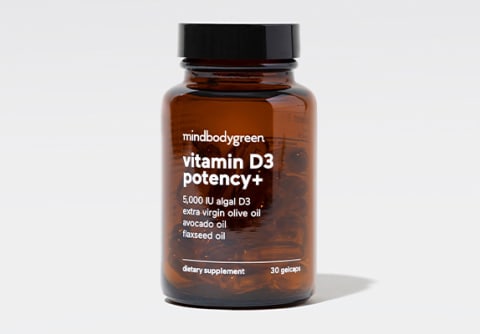
mbg Beauty Director
mbg Beauty Director
Alexandra Engler is the beauty director at mindbodygreen and host of the beauty podcast Clean Beauty School. Previously, she’s held beauty roles at Harper’s Bazaar, Marie Claire, SELF, and Cosmopolitan; her byline has appeared in Esquire, Sports Illustrated, and Allure.com.

Image by Ohlamour Studio / Stocksy
August 15, 2024
We carefully vet all products and services featured on mindbodygreen using our
Our selections are never influenced by the commissions earned from our links.
Did you know that clinical vitamin D insufficiency persists in almost half (41%1) of the population? This is a problem because vitamin D plays a critical role in several functions in the body, from bone health to thyroid function.
However, controversies arise when you discuss the most effective ways to increase your natural levels. Vitamin D can be consumed via a few food sources or supplementation or synthesized in the skin via ultraviolet radiation.
So while sunlight can help increase natural vitamin D levels in the body, UV radiation is notorious for triggering skin cancers, damage, and premature aging, which means folks are stuck in a tricky place when it comes to the sunshine vitamin.
That’s why I asked board-certified dermatologist Shasa Hu, M.D., professor at the University of Miami, about this exact topic. And she noted that the link between sunlight, vitamin D, and optimal absorption actually bears out in research.
But first: What is vitamin D, and why is it so important?
Vitamin D is both a vitamin and a preprohormone (which gets converted to a full-on hormone in its active form in the body). It’s essential for several functions:
- Vitamin D plays a crucial role in thyroid health, as it helps regulate the production of thyroid hormones2, which have widespread roles in the body including metabolism, weight, mood, the sleep cycle, musculoskeletal health, reproductive health, and immunity.
- Optimal vitamin D levels have been shown to positively affect our immune pathways, including supporting white blood cell function3 and helping the immune system adapt to and ward off threats4.
- Vitamin D has been shown to play a role in promoting beneficial gut bacteria.
- Vitamin D is also critical for your bones because it helps the body absorb minerals, like calcium and phosphorus, which are essential structural elements of our bones.
Vitamin D and the skin: What does the research say?
Here’s the thing: You can get vitamin D from sunlight, but for many, sun exposure alone is often not enough to provide all the vitamin D that your body needs.
For example, location often plays a role: Research8 suggests that if you live above or below a certain latitude (33 degrees, specifically), you’ll be unable to produce vitamin D from sunlight during the winter months.
Environmental factors can also influence your skin’s ability to create vitamin D. For example, air pollution8 and particulate matter have been shown to interfere with vitamin D production.
And skin tone plays a role in the body’s ability to produce enough vitamin D. Larger amounts of melanin9 in the skin affect the skin’s ability to produce vitamin D from UV rays; people with darker skin tones need longer exposure to the sun (up to two hours a day!) to produce adequate vitamin D levels. Of course, this is often not possible.
And even when individuals have met the sunlight requirements to obtain adequate vitamin D, it’s still not always enough, notes Hu. In fact, she says, research has found that individuals who spend all day in the sun without sunblock can still be vitamin D deficient10.
What’s more, attempting to get enough vitamin D from sunlight risks exposing you to unsafe skin practices. Excess sun exposure, after all, is the source of about 80% of visible signs of skin aging11 and a major cause of serious skin issues (the most notable being melanoma). And even if you ignore these risks, you still might wind up vitamin D deficient!
The verdict: While getting vitamin D through the sun is possible, it’s not always the right answer.
Vitamin D absorption in the skin vs. the gut: The case for the gut
According to Hu, “It’s much safer and more reliable to take a vitamin D [supplement] than go in the sun, get sunburned and potentially skin cancer because of that fear of vitamin D deficiency.”
One study even pinned supplementation and sunshine against each other, finding that those who took a modest level of oral vitamin D supplementation (1,000 IU of D3 taken daily) experienced an increase in vitamin D blood levels. Participants who chose to rely on sunlight exposure, on the other hand, had no significant increase.
“There are also a lot of other studies supporting that our skin’s capacity to convert vitamin D from sun exposure declines over age12, but our GI absorption stays relatively stable,” Hu explains. Meaning, older adults experience a reduced capacity to produce vitamin D313 from UVB radiation.
Of course, you can look for vitamin D through whole foods like fatty fish, liver, red meat, milk, and some mushrooms, but eating enough to reach sufficiency can be challenging. Most folks who struggle with deficiency opt for a supplement.
The takeaway
It’s understandable folks might be worried about their vitamin D levels, given how much the vitamin does in the body and how ubiquitous deficiency is. And while sunshine can help the body produce vitamin D, it’s not the most effective way to go. Opt for a quality vitamin D supplement instead.

